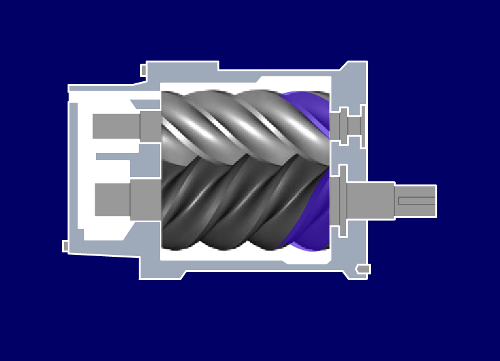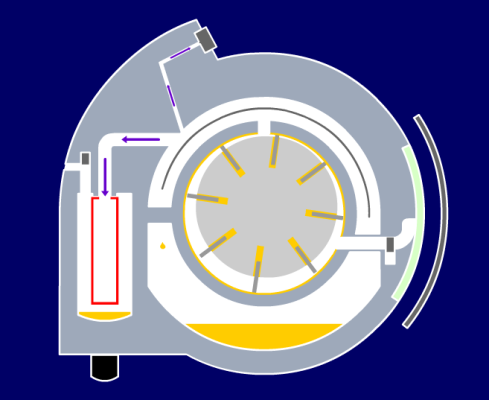Regardless of the compressed gases and operating parameters, the following types of compressors are distinguished by structures:
1. Volumetric action – reciprocating type-piston, membrane; rotary type- scroll, screw, rotary vane, lobe type,
liquid ring, trochoid, rolling rotors type, with partial internal compression.
2. Dynamic action – centrifugal, axial, side channel and jet.
Piston compressors
Reciprocating piston compressors have been manufactured and used as a source of gas compression for more than a hundred years. Any piston compressor consists of a crankshaft, a connecting rod and a piston group, a cylinder block, and valves. During compressor operation, inertia forces arise, caused by the reciprocating movement of the connecting rod and piston group and leading to vibrations. To reduce them, counterweights are installed on the crankshaft. A flywheel is used to increase the smoothness of the compressor.
In the compressor industry of piston type compressors, there are a number of basic design schemes for multistage machines – opposed, L-shaped, V-shaped, W-shaped. The opposed scheme is the most balanced, in-line, L-shaped, V-shaped, W-shaped are the most compact solutions. Crosshead and non-crosshead compressors are also distinguished by design. Crosshead compressors are most often used for double-acting and oil-free compression cylinders. High-pressure compressors with a large number of compression stages often use double-acting pistons, which greatly simplifies the design of the compressor.
The modern application of reciprocating compressors is huge in industry. Blowing of PET bottles, gas extraction, compression and booster of various industrial gases in the range from 20 to 600 bar(g) and more, refrigeration gases compression.
The most innovative are Ariel, IngersollRand, AtlasCopco, Reavell.
Diaphragm compressors
Diaphragm compressors are a fairly new technology in the compressor industry and its development is directly related to the development of structural materials. In general, membrane compressors are similar to piston compressors: the membrane compressor also has a crankshaft with a connecting rod, a cylinder block with valves, but the working element is not a piston, but a flexible membrane.
In industry, diaphragm compressors have become widespread where very high purity of the compressed gas is required and for compressing aggressive and explosive gases. Range of application – small and medium performance in the high pressure range from 200 to 4000 bar(g).
Diaphragm compressors are dry compression compressors and can be used to compress any gas.
Manufacturers: AndreasHofer, PDCMachines
Scroll compressors
Scroll compressors are also fairly new engineering developments. The scroll compressor consists of two scrolls – one fixed, the second makes a circular motion and has an anti-rotation device. Scroll compressors come with a vertical and horizontal axis of movement of the movable scroll.
Scroll compressors are widely used in refrigeration as a device for compressing freons.
Range of application – machines of low cooling capacity. They can be with dry compression or with injection of liquid.
The most famous companies developing spiral technology are Daikin, Danfoss, Copeland.
Screw compressors
Screw compressors became widespread in the 60-70s of 20 century. Traditionally, a screw compressor consists of two screw rotors (single screw compressors also exist). There are oil-free compressors, water injected compressors and oil injected compressors. Also, screw compressors are divided according to the profile of screw pairs into asymmetric and symmetrical.
Screw compressors are balanced, do not have valves and dead volume and have forced gas distribution through windows.
In industry, screw compressors have taken a firm place as a source of compressed air for general industrial purposes in the pressure range from 4 to 15 bar(g) and capacities from 4 to 500 m3/min. Because of the balance, screw compressors are manufactured as diesel-driven mobile compressors.
Screw compressors are widely used in refrigeration technology for compressing a lot types of freons and ammonia in the range of medium and high cooling capacities. Among the companies with the most experience and with the most interesting solutions in the field of screw compressor design are AtlasCopco, Kaeser, IngersollRand, CompAir, Bitzer.
Rotary vane compressors
Rotary vane compressors began to be used in industry in the 50s of 20 century. The rotary vane compressor consists of a rotor eccentrically displaced relative to the stator axis. In the grooves of the rotor, plates are located radially or inclined, which, during rotation, due to the action of centrifugal force and gas forces, are pressed against the stator wall.
Structurally, rotary vane compressors are divided into oil-free and oil-filled. Oil-free compressors use graphite plates, while oil-filled compressors use metal plates. Also, compressors are produced with a horizontal and vertical axis of rotation of the rotor. Vertical compressors have a more compact design. The gas distribution of these machines is forced through the windows. Due to balance it is widely used intransport.
In industry, rotary vane compressors have become widespread in refrigeration in the range of low refrigerating capacities, and are also used to compress air and gases. Air machines of the rotary vane type are made with a discharge pressure of 1 to 10 bar(g), they are used as vacuum pumps or as a source of compressed air for general industrial purposes in the performance range from 0.1 to 30 m3 / min at 10 bar(g) in one stage. Among the well-known and experienced companies are Danfoss, DemagWittig, Hydrovane, ElmoRietchle, BeckerKompressoren, Busch.
Lobe type
Lobe type compressors consist of two rotors working in non-contact engagement. According to the number of rotor blades, compressors are divided into two- and multi-blade.
All compressors of this type are oil-free and, as a rule, are used for pressures from 0.1 to 1 bar(g). The performance range of the optimal application of these compressors is from 1 to 40 m3/min. These are machines with external compression, balanced.
In industry, these compressors are most often used for pneumatic conveying of bulk materials, as well as vacuum pumps.
Well-known manufacturers include Aerzener, AtlasCopco, Gardner Denver, Robuschi, IngersollRand.
Centrifugal compressors
Centrifugal compressors were widely used in industry in the 1960s. of 20 century. The design of centrifugal compressors is quite simple. The centrifugal compressor consists of an inlet device, an impeller (impeller), a diffuser and an outlet device. In the centrifugal wheel, the compressible medium accelerates, and in the diffuser, the kinetic energy of the flow is converted into potential pressure energy.
By design centrifugal compressors are divided into single-stage, single-sided and double-sided, single-shaft and multi-shaft. According to the type of impellers, centrifugal compressors are divided into closed, semi-open and open. According to the location of the wheels relative to each other, centrifugal compressors are divided into unidirectional and opposite. These are machines with dry compression, high-speed.
Centrifugal compressors have received wide industrial application in the glass and coal industries, metallurgy and mechanical engineering, and in the oil and gas industry and refrigeration as well. Centrifugal compressors are the main source of compressed air production for general industrial purposes at large enterprises; as part of natural gas transport unit centrifugal compressors are involved in the process of transporting natural gas. Also very often centrifugal compressors serve as a source of compressed air for large air separation plant. In refrigeration, centrifugal compressors are used for machines with large cooling capacities (up to 2000 kW).
Among the most innovative companies in the field of centrifugal compressor construction are IngersollRand, AtlasCopco, Danfoss (Turbocor), Siemens, MANTurbo.
Axial compressors
Axial compressors are a type of dynamic compressors or turbochargers, but unlike a centrifugal compressor, axial compression occurs along the axis of the shaft. By design axial compressors are single- and multi-stage. Also, axial compressors can differ in the type of blades.
Axial compressors have received wide industrial application in the aircraft industry, as well as in industrial processes where huge capacities (from 2000 m3/min) and low pressures (1-10 bar (g) are required. Also, axial compressors can be used as part of a combined compressor as initial stages.
Among the manufacturers of axial compressors from purely compressor companies, we can distinguish Siemens, Elliott, MANTurbo.
Side channel compressors
Side channel compressors are relatively new machines. The beginning of their research and application dates back to the 50s. 20 century. The side channel compressor consists of an impeller, on which the blades are evenly located along the circumference, a suction, discharge working channel. The suction and discharge channels are separated by a special partition, which is also called a separator or cut-off.
Side channel compressors, according to the principle of energy conversion, belong to machines of the dynamic principle of operation.
With all the advantages of these machines, side channel compressors are distinguished by their simple design, and low cost of manufacture, their operation is stable over the entire range of regime parameters, and there is no surge phenomenon inherent in centrifugal compressor machines. The maximum efficiency of side channel compressors is achieved at relatively low rotational speeds and circumferential speeds, which makes it possible to perform side channel compressors without multipliers.
In the first approximation, the working process in the stage of a side channel compressor can be considered similar to the process in a centrifugal compressor with multiple circulation of the compressible medium through the impeller and fixed elements of the stage. Particles of the working medium move from the suction pipe to the discharge pipe along a complex spiral trajectory and the impeller blades, unlike other dynamic compression machines, not one, but several times act on gas particles. This circumstance provides a much greater pressure of side channel compressors than centrifugal ones.
Due to the fact that this type of compressors appeared relatively recently and is technically presented in a very narrow range of capacities/pressures (up to 100 m3/min and up to 0.8 bar(g), the industrial use of this type of compressors is small. Among the industries where side channel compressors are most commonly used are mining, printing, food and chemical industries. Recently, side channel compressors have been used for aeration of wastewater.
Among the companies that are developing this technology are ElmoRietchle, BeckerKompressoren.
Article prepared by:
Head Department of Technical Thermophysics of Sumy State University
Vaneev S.M.














